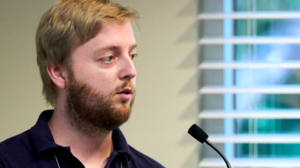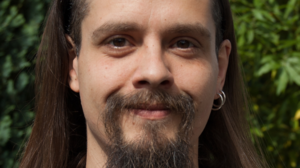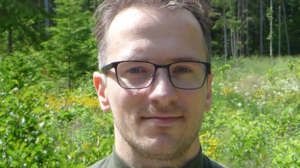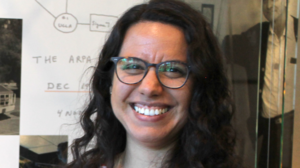Funded researchers: Dr. Mats Leifels, Dr. Wiebke Kämper, Dr. Sebastian Kruppert, Dr. David Adam, Dr. Andreas Marzoll, Dr. Claudia Mazziotti & Dr. Pascale Willemsen
Dr. Mats Leifels
Biology and Biotechnology

Due to their abundance in aquatic resources, high resilience towards environmental factors and the low dose of infection, the presence of even few infectious virus particles in large volumes of water is a threat to the public especially if used for drinking water production, recreational purposes or irrigation.
While a wide array of analytical methods such as cell culture and qPCR are available to detect various enteric viruses, each approach has its own specific disadvantages: cell culture, while being the gold standard of virology, is able to account for every viral particle but no assay is available to detect human norovirus. Additionally, it is cost- and labor-intensive, requires experienced personnel and special safety clearance and lacks the ability to differentiate between different strains of virus families which makes it necessary to include follow-up molecular or immunological assay.
Molecular assays provide the sensitivity and specificity needed to investigate aquatic viruses, still, there are significant limitations since qPCR only detects naked nucleic acid regardless of infectivity and is susceptible to co-concentrated inhibitory substances which may lead to false negative results.
Capsid integrity (ci-) qPCR is a method proposed by my first publication and which is planned to be adapted for norovirus during the fellowship. The technique takes another approach than conventional qPCR: Sample pretreatment with ethidium monoazide (EMA) and propidium monoazide (PMA) could be shown to increase the ability to differentiate between infectious and non-infectious viruses since both capsid-impermeable reagents contain an azide group which covalently binds to accessible nucleic acids if activated by light and forms an irreversible complex with the genome. This complex de-attaches the polymerase in a follow-up qPCR, thus suppressing false-negative results. The success of that method in differentiating between infective and non-infective various enteric viruses has be shown in recent literature.
An adaption version of the ci-qPCR will be developed and implemented for relevant viruses (e.g. human norovirus and hepatitis A virus) which have the resilience to endure the a decentralized waste water treatment. The molecular capsid properties and entrance pathways of both EMA and PMA will be assessed for different viruses and further applications of the innovative method will be evaluated in close collaboration with the scientific staff of the School of Public Health.
Dr. Wiebke Kämper
Biology and Biotechnology

Pollination is a critical ecosystem function and essential for natural and agricultural productivity. Globally the majority of wild flowers and crops rely to some extent upon animal pollination. Here, the most important pollinators are bees (Hymenoptera: Apidae) but recent scientific reports have shown that bees decline in abundance and diversity. For successful pollination roughly 50 % of plant species rely on or benefit from cross-pollination provided by e.g. bees. With ~20,000 bee species worldwide, which differ in morphology and foraging behaviour, it seems likely that species differ in the ability to carry and move cross pollen. However, despite the importance of cross-pollination surprisingly little is known about the ability of different bee species to move cross pollen.
In my project, cross pollen movement in avocado and macadamia orchards will be studied. In avocado and macadamia, like in many other crops, cross-pollination occurs if pollen of one cultivar is moved by pollinating agents from the anthers of one plant to the stigma of another plant with deviating genotype. As study systems avocado and macadamia are particularly interesting because they both are characterised by excessive flower and fruit abscission, which indicates a lack of cross pollen flow.
The aim of my GF project is to investigate how introduced managed honeybees and native wild bees forage and how their foraging decisions affect their ability to carry and move cross pollen. Moreover, I will investigate whether pollen flow due to bee pollination has benefits for plant reproductive success at different distances from the hive and in different orchard designs.
The outcome of this research gives insight on how honeybees and wild bees forage and whether this affects (i) the likelihood to move cross pollen and (ii) the plant reproductive success. The results of this research will be applicable and most relevant to agricultural as well as natural ecosystems.
The host of my GF project is Prof Dr Helen Wallace, who is a Professor in Agricultural Ecology and the director of the GeneCology Research Centre at the University of the Sunshine Coast, Australia. She is an esteemed expert in Agricultural Ecology, has published in renowned journals and the Australian Centre for International Agricultural Research has awarded her two large project grants this year.
Dr. Sebastian Kruppert
Biology and Biotechnology

Climate change has severe impacts on marine ecosystems. Especially decreasing sea water pH values driven by atmospheric CO2 taken up by the oceans has been shown to decrease growth and fitness of calcifying organism like stony corals and mollusks. The latter depend on their heavily calcified shells as body armor against smashing predators. Among the mollusk hunting predators, mantis shrimps are intriguing due to their ability to launch brute attacks against mollusk shells. Although negative effects of decreasing pH on mollusks has been reported it has not been linked to their shell based protection against smashing predators. Decreasing calcification rates may have negative influence on their predation vulnerability due to more fragile shells. Higher vulnerability and consequently increased predator success rates potentially lead to a shift in predator’s prey preferences influencing whole ecosystems.
In my GF project I will analyze the impact on pH decrease on the shell biomechanics of three Californian mollusk species (Lottia gigantean, Leptopecten spp, Cypraea spadicea) with regard to the attack forces of their coexisting mantis shrimp predator Hemisquilla californiensis. Therefore, I will culture the three prey species in two different pH values representing current ocean and predicated average values. Subsequently, I will compare their shell biomechanics using empiric tests as well as physical simulations to unmask the impacts of pH decrease on the biomechanics of marine predator prey interactions. These results will consolidate estimations on marine future ecosystems’ condition.
Host of my GF is Jennifer Taylor at the SCRIPPS institution of Oceanography, San Diego, California. She is an expert in crustacean ecology, has extensively worked on mantis shrimps and conducted several studies on the effect of ocean acidification on different marine taxa. My host institution, the SCRIPPS, is one of the leading marine research facilities in the USA and provides a broad range of methods and expertise in marine sciences.
Dr. David Adam
Biology and Biotechnology

The development of H2-evolving systems provides a route to effectively utilize and store renewable energy. A prerequisite for a regenerative hydrogen production is the availability of inexpensive and stable biocatalysts such as [FeFe]-hydrogenases which convert protons and electrons into H2 at extraordinary high rates and at low over potential.
Diffusible compounds, enzyme stability and harmful end products of the sacrificial electron donor have been identified as the limiting aspects for light driven hydrogen production. Due to the variability of base sequence and local complementarity patterns DNA can adopt all kinds of 3D-structures to bind components of various sizes and compositions such as photosensitizers, polypeptides or even complex enzymes. By exploiting this scaffold function the interaction partner configuration and closeness can be optimized which should be reflected in enhanced performance and system stability. The introduction of enzyme and photosensitizer into a common DNA scaffold creates modular subunits which can be treated as single units. For biotechnological applications the connection of modular subunits to larger units is planned. These larger units can be grafted on electrode surfaces which ensure electron supply without local formation of harmful side products by consumption of sacrificial electron donor.
The host of my GF project is Prof Dr Itamar Willner, who is a Professor in Chemistry and an expert on the field of photocatalysis and nucleoapzymes. Prof. Willner released more than 720 publications, holds 30 patents and has been honored with numerous awards (Thomson Reuters –Highly Cited Researcher and listed in the World’s Most Influential Scientific Minds 2014 and 2015 / The Klachky Family Prize for the Advancement of the Frontiers of Science 2003).
Dr. Andreas Marzoll
Neuroscience

Throughout life, sensory systems in the human brain have the capacity to adapt to new challenges. This form of plasticity is called “perceptual learning”. One real-life example is the training of radiologists, who are only able to detect subtle visual signs of disease in X-ray photographs after being exposed to thousands of such images early in their career. In basic research, simple stimuli are used to elucidate the principles of perceptual learning and to identify brain regions associated with it.
Many factors play a role, such as attention, reward, training schedule and optimal stimulus presentation. In recent times, experimental paradigms have been developed to investigate the role of these factors more closely. One such paradigm is task-irrelevant perceptual learning, which shows that training on the perceptual tasks themselves is not necessary if learning can “piggy-back” on top of irrelevant tasks, as long as passive stimulus presentation occurs simultaneously with reward signals elicited by the irrelevant task.
In a related approach, completely passive sensory stimulation protocols have been developed that induce perceptual learning by using temporal patterns that are derived from cellular stimulation protocols known to selectively alter synaptic strength (long-term potentiation and long-term depression). The investigation of visual stimulation protocols that apply this principle was the focus of my prior work.
In my gateway fellowship project, I will further investigate principles of perceptual learning by combining these two approaches and use brain imaging methods (fMRI) to detect the sites and nature of changes in visual cortical areas of the human brain. The host of my gateway fellowship project is the Fred M. Seed Professor of Cognitive, Linguistic and Psychological Sciences, Takeo Watanabe, who is located at Brown University (Providence RI, USA). He discovered and subsequently investigated task-irrelevant perceptual learning as well as brain processes related to perceptual learning and is an eminent researcher in the field, with many publications in high-impact journals under his belt.
Dr. Claudia Mazziotti
Educational Research

Adaptive educational technologies (EdTechs) have proven their effectiveness for students’ learning in a number of studies and begin to proof effectiveness also for teachers’ work facilitation However, while in other countries such as the U.S. EdTechs are successfully implemented, in German schools they are used very rarely as the International Computer and Information Literacy Study (2013) showed . There are a many reasons for Germany’s low EdTech use: In parallel to insufficient IT infrastructures at schools, teachers’ expectations regarding the technical and expert support during the use of EdTechs as well as considering the integration of EdTech not to be a priority seem to hinder teachers from using adaptive EdTech more regularly.
With my Gateway Fellowship (GF) project I aim to contribute to address these issues by learning from U.S. best practice examples at the Center for Technology in Learning at the Stanford Research Institute (SRI Menlo Park, California). More precisely, my first goal is to interview EdTech experts from the numerous EdTech projects at SRI who already successfully implemented EdTechs in practice. To serve as additional incentive for teachers to actually make use of EdTechs my second GF goal is to set the theoretical stage for the future development of an EdTech facilitating both students’ learning and teachers’ work. The envisioned EdTech will enable students to collaboratively engage in exploratory more open-ended learning activities and teachers to monitor and adapt to students’ learning progress over a so-called teacher dashboard. So far, learning science research has not examined how all three components (students’ collaboration, students’ exploration and the teacher dashboard) jointly evolve their benefits. By striving towards both GF goals, I aim to contribute to transferring research into practice.
Dr. Pascale Willemsen
Philosophy

It is generally assumed in philosophical debates that in order to be morally responsible for an event one has to be directly involved in the causal chain leading to that event. For example, if your boss blames you for having deleted important data from his computer, then we assume that your boss also believes that you were causally involved in the deletion of the data – for instance by pressing ‘delete’. Otherwise, we would reject her moral judgment as faulty. The legal system operates in a similar fashion. There is now a lot of empirical evidence demonstrating that moral judgments affect judgments about causation, such that people’s causal judgments are shaped by their intention to blame the agent. This effect poses many challenges for philosophers of morality and also for philosophers of causation. Moral responsibility judgments are supposed to be built on a purely descriptive causal judgment, not to influence those causal judgments. In addition, the metaphysical concept of causation does not allow for norms, as causation is typically thought of as a relation in the wold.
My GF project aims to investigate how devastating this effect really is. There are two ways to challenge the extent empirical data. First, only one empirical research method has been applied to investigate people’s causal intuitions, namely vignette studies. However, vignette studies suffer from many methodological limitations that make them unfit for many relevant research questions concerning people’s causal intuitions. The first aim of my GF project is to extend this research to a wider range of methods, such as video stimuli and eye-tracking and response time measures. If the effects are genuine effects and not experimental artifacts, we should confirm them using different empirical tools. Second, it might be objected that when asking participants about causal and moral responsibility, participants mix up the two questions and actually integrate a lot of their moral evaluation into the causal judgment. Thus, the effects that have been obtained might, again, be experimental artifacts, resulting from pragmatic features of the experiments. The second aim of my GF project is to test this possibility, using a variety of cover stories (including scientific, medical, and legal contexts) and test queries that disambiguate moral and causal responsibility more clearly. As a result of these two novel approaches to causal judgments, my research will contribute to a deeper understanding of the connection between causal and normative, moral judgments and the underlying cognitive processes.
Host of my GF fellowship is Prof. Dave Lagnado at the University College London. He is the head of the Causal Cognition Lab and his research focuses on the psychological processes that underlie human learning, causal and legal reasoning and decision-making. The team I am working with is very interdisciplinary, combining expertise from philosophy, psychology, legal theory, and decision theory. All these perspectives shed slightly different light on the questions at hand and they help get a more nuanced and global picture. As a city with many different, vivid and renowned universities, London provides many possibilities to extend my network und participate in an inspiring academic life.
- Forschungsbezogene Kompetenzen: Workshops & Veranstaltungen
- Karrierevorbereitung: Workshops & Veranstaltungen
- Forschungsmanagement Skills: Workshops & Veranstaltungen
- Liste aller Workshops & Veranstaltungen
- Förderprogramme zur Internationalisierung
- Beratung & Ombudsperson
- Promovierenden-Datenbank
- Welcome Hour
- Newsletter


